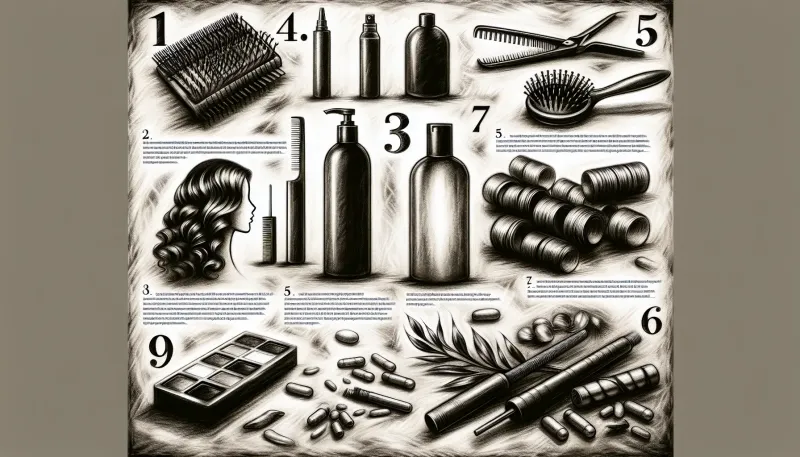Top 5 Oily Hair Styling Tools and Techniques for Sleek, Manageable Locks

Discover the best oily hair styling tools and techniques to achieve sleek, manageable locks. Learn the top 5 solutions and transform your hair care routine.
Struggling with oily hair can be a never-ending battle for many people. Excess oil can make your locks look greasy, flat, and unclean, even shortly after washing. Fortunately, there are specific oily hair styling tools and techniques that can help you achieve sleek and manageable hair. In this article, we will explore the five most effective tools and techniques to keep your hair looking its best.
Understanding Oily Hair
Oily hair is often the result of overactive sebaceous glands on the scalp, which produce an excess of sebum. While some sebum is necessary for keeping hair healthy and moisturized, too much can lead to a greasy appearance. Various factors such as genetics, diet, and hair care habits can exacerbate this condition. By using the right tools and techniques, you can manage oily hair more effectively.
Top 5 Oily Hair Styling Tools and Techniques
1. Dry Shampoo
Dry shampoo is a game-changer for those with oily hair. This product comes in both spray and powder forms and works by absorbing excess oil from the scalp and hair, giving your hair a fresh appearance without the need for washing. Opt for a formula specifically designed for oily hair, as it will be more effective in controlling sebum production.
2. Boar Bristle Brush
A boar bristle brush is a fantastic tool for those with oily hair because it helps to distribute natural oils from the scalp down the length of the hair shaft. This prevents oil from accumulating at the roots and helps maintain a more balanced oil distribution. When brushing, start from the roots and work your way down to ensure even distribution.
3. Clarifying Shampoo
Using a clarifying shampoo once a week can help remove built-up oil, dirt, and product residue from your hair and scalp. These shampoos are formulated to provide a deep clean, which is particularly beneficial for those with oily hair. Be cautious not to overuse clarifying shampoos, as they can strip away natural oils and lead to increased sebum production as your scalp compensates.
4. Hair Serums for Oily Hair
Hair serums can be a helpful addition to your hair care routine. Look for lightweight, oil-free formulas designed for oily hair. These serums can tame frizz, add shine, and protect hair from heat damage without adding extra oil. Apply a small amount to the ends of your hair to avoid weighing down your roots.
5. Microfiber Towels
Using a microfiber towel to dry your hair can significantly reduce the amount of oil produced by your scalp. Microfiber towels are gentler on hair compared to regular towels, causing less friction and reducing the need for vigorous rubbing, which can stimulate oil production. Gently blot your hair to remove excess moisture without overworking your scalp.
Additional Tips for Managing Oily Hair
Avoid Over-Washing
While it may be tempting to wash your hair frequently to combat oiliness, over-washing can strip your scalp of natural oils, prompting it to produce even more sebum. Stick to washing your hair two to three times a week and use the appropriate products for oily hair.
Use Cold Water for Rinsing
Hot water can stimulate the sebaceous glands and increase oil production. Rinsing your hair with cool or lukewarm water can help keep oiliness at bay and leave your hair looking shinier and healthier.
Avoid Heavy Styling Products
Heavy styling products like certain gels, creams, and waxes can weigh down your hair and make it appear greasier. Opt for light, oil-free styling products and use them sparingly to maintain a fresh look.
Mind Your Diet
What you eat can impact the condition of your hair. A diet rich in healthy fats, such as omega-3 fatty acids, and vitamins like B6 and B12 can help regulate sebum production. Avoid excessive consumption of greasy and sugary foods to keep your scalp balanced.
Conclusion
Managing oily hair requires a strategic approach using the right tools and techniques. By incorporating dry shampoo, a boar bristle brush, clarifying shampoo, hair serums, and microfiber towels into your hair care routine, you can achieve sleek, manageable locks. Additionally, following tips such as avoiding over-washing, using cold water for rinsing, and maintaining a balanced diet can further help control oil production. By understanding your hair's specific needs and addressing them effectively, you can enjoy healthy, clean, and beautiful hair every day.



























